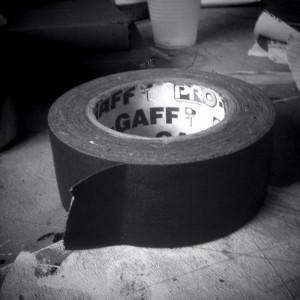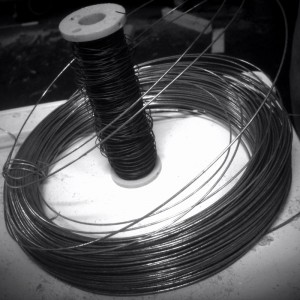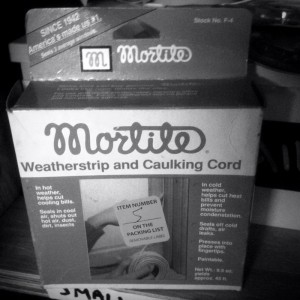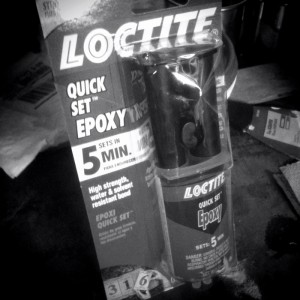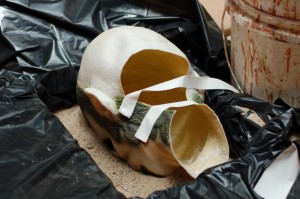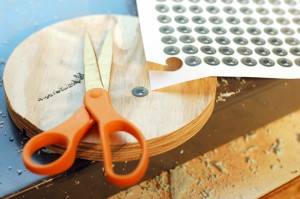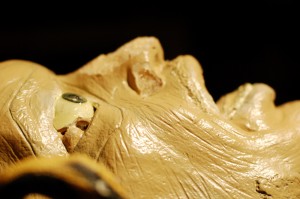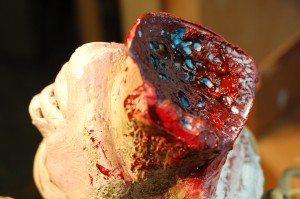First, I wish to offer a caveat; I don’t write much about safety, because it’s a highly complex area, especially once you start talking about safety around chemicals. I’m not an expert, and if you are in a workplace situation, there are actual regulations, standards and laws that need to be followed. The last thing I want is someone’s sum total of knowledge about safety coming from “Eric Hart’s Props Blog.” Still, the home hobbyist may not know where to look for information, and the prop shop employee may not know what questions to ask their employer, or what their employer is responsible for providing. Thus, what follows is not a guide for choosing the right disposable glove; rather, it is a guide to what questions to ask and what information to look up to learn which disposable gloves are best for each situation. All the safety data in the world is useless if we don’t know what information we are trying to find, or even that we need to find certain kinds of information. Often, we don’t know what we don’t know.
Dozens of companies make disposable gloves, offering hundreds of combinations of materials, thicknesses and liners. You need to find the permeation data for the specific gloves you are using. This will tell you how long it takes for specific chemicals to work their way through the glove and onto your skin.
No single glove will protect you against every chemical. There were approximately 50,000,000 chemicals registered by the CAS on September 7, 2009, with more being added at the rate of twenty-five per minute. Luckily in theatre, we only use a small percentage of those chemicals. If you work at a theatre or shop in the USA that employs ten or more people (that’s counting the whole theatre, not just the prop shop), then it is subject to OSHA regulations, and your employer is required to inform you of any toxic chemicals you may be using.
As a general rule of thumb, you should be wary of rules of thumb when it comes to safety. But a good rule of thumb to follow in safety is “don’t get stuff on you, and don’t breathe anything that isn’t air.” Choosing the right glove falls under the “don’t get stuff on you” part of the rule. Gloves are necessary because many chemicals can be absorbed through the skin. Chemicals commonly used in prop shops that can be absorbed through the skin include solvents and epoxies. Solvents don’t just include pure solvents like acetone, xylol and mineral spirits, but also any product that includes solvents: spray paints, cleaners, adhesives, etc.
Another good rule of thumb is that latex gloves don’t stop any chemicals. They can keep your hands dry, and they’re great for keeping blood and other bodily fluids from getting on your hands. They’re also useful for the reverse: keeping your own sweat and oils from getting onto your work surface. But as far as working with any sort of industrial or household chemicals, they may as well be invisible.
Notice how I mentioned household chemicals above. Just because you can buy something in a grocery or drug store doesn’t make it safe to work with without proper protection. For example, many cleaners like Windex, 409 and Simple Green use a chemical called 2-Butoxyethanol. The toxic exposure level of 2-Butoxyethanol is less than that of acetone and hexane, placing it in the category of “highly toxic” chemicals. When you start looking at permeation charts for popular glove brands, you see a trend; latex gives you no protection, while neoprene and vinyl will offer only several minutes before exposure begins. If you are using anything other than nitrile, you are exposing yourself to a highly toxic chemical.
If you are using a glove and the substance is splashing or spilling onto your bare arm, it defeats the purpose. Make sure you are wearing sleeves that offer similar chemical protection, or use longer gloves.
Many chemicals we use for prop making are toxic through skin absorption. An example is any of the two-part epoxies we use: sticks of epoxy putty, five-minute epoxy glue, epoxy coatings for fiberglass and carbon fiber, epoxy resin for casting. Epoxy is a sensitizer, which means our bodies do not react to it on the first exposure. Rather, it is on the second or subsequent exposures where we develop what is essentially an allergic reaction. It can even be after decades of using a product before one reacts to it. But reaction can be severe. Here is a chilling but not uncommon description of a reaction:
Open, oozing, and itching insanity hives virtually all over my body and my eyes literally were swollen shut for a week on two separate occasions. Recovery, each time, took better than a month.
Once developed, it is not reversible, and occupational physicians may advise you to not only never use epoxy again, but none of the “two-part” chemicals in that category. No more Smooth-On products, Great Stuff, A-B foam, etc. If you make your living as a props artisan, you pretty much have to do all your molding and casting out of plaster.
It is important to note that permeation data charts tell how long it takes for a chemical to permeate through a glove. This implies that no glove will offer permanent protection; they are called “disposable” for a reason. In fact, the most a glove gets tested is for 6 hours. If you use a pair of gloves all day, don’t set them aside for the next day. In fact, you should throw the gloves away. Trying to stretch the use of a pair of gloves to save money may seem thrifty, but it is actually counter-intuitive. The same is true of any safety measures and products you use. If you use or reuse them improperly, you get the worst of both worlds; you are spending money but not keeping yourself safe. If you feel you are spending to much money on safety equipment to make props, the best solution is to stop making props. You don’t go scuba diving without an air tank. We often get in situations where the easiest solution seems to be to continue on and finish a prop; it’s late and you’ve run out of gloves, and all the hardware stores are closed, and all you need to do is get one more coat of epoxy on so it can cure by the morning and they can use the prop in rehearsal. When you get to those situations, remember this: Your goal in life is not to finish that single prop. Your goal in life is to build props for the rest of your life. Taking shortcuts now will affect your health later on. No prop in the existence of humankind has ever been more important than your health.
A good shop foreman will be consistent in his or her purchasing of disposable gloves, so you don’t have to hunt down the permeation data every time he or she buys a new brand.
In conclusion, don’t get stuff on yourself. You should know what is present in any material or substance you are working with. If it includes chemicals that can be absorbed through your skin, you need to find out what glove will offer protection from that chemical, and how long it will offer that protection. Remember that gloves from different companies may differ in their permeation data, even if all the stats on the box seem the same.



